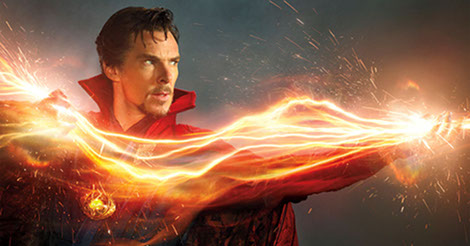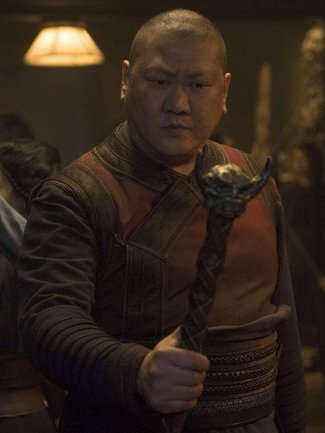
Note: The following is a discussion of themes in Doctor Strange which touches on some plot points.
There is no forbidden knowledge … only certain practices.
So cinema’s greatest action librarian Wong informs Dr. Strange when he inquires about certain magic tomes. If Strange were studying at Hogwarts, those books would occupy the restricted section. Instead he is a novitiate at Kamar-Taj, more a dojo of the mystical arts than a magic academy within the Marvel superhero film universe. This more libertine policy reminds me of Paul: “‘Everything is lawful,’ but not everything is beneficial.” And yet Doctor Strange is definitely the sort of film that one chapel speaker or another would have warned me about during my Christian school career.
The eponymous hero of Doctor Strange learns sorcery after a car accident ruins his hands and consequently his career as a preeminent neurosurgeon. His studies carry him to vistas of pure computer graphics inspired by the psychedelia of the 1960s which birthed the original comics. His teachers exhort him to “forget everything you think you know” which may suggest to some a kind of mind-emptying meditation at odds with a God-and-scripture-centered practice. Yet the film is also determined to mesh seamlessly with the previous 13 Marvel movies which were heavy on the science fiction. And Strange himself has no intention of turning his back on years of scientific training; there’s a running gag of him reminding everyone to call him “doctor” (understandable given that he earned an MD and a PhD simultaneously). Christians interested in reconciling their traditional faith with modern science will consequently find many of the conversations in the movie familiar.
The Ancient One, Strange’s sensei in sorcery, shows him there is more to the world than the material universe. Or so she claims; what he experiences is still mediated by his senses and so potentially physical. So it’s no surprise she describes magic in terms of energy and natural laws and programming. In this world, magic isn’t a matter of imagination or will, but of years of study and practice. We get the impression the mystic dimensions the Ancient One reveals could be interrogated with the tools of science even if they are taught as matters of faith. And she casts spells which suggest the way Iron Man manipulates his futuristic-but-plausible holographic computer interfaces. If we are at the place where the natural and the supernatural meet, it is a place of fruitful collaboration, not strident conflict.

Strange is not the Ancient One’s only disciple. The requisite villain Kaecilius was formerly of her dojo. He departed to pursue eternal life. When opposing ideologies clash, Strange finds himself insisting that finite lives can still be significant in the face of the infinite, a nice reversal of his previous assertion to the contrary when he was a confident philosophical materialist. I was reminded of a similar conversation between Vision and Ultron in last year’s Avengers: Age of Ultron. Ultron sought immortality by becoming indestructible; Kaecilius seems to think the stasis of oblivion is the path to eternity (although I’ll confess to some uncertainty about his motivation). Strange stands instead for life, more specifically for growth and transformation, an eternal continuity rather than fixed form or substance. As a Christian awaiting a new creation, I found Strange’s perspective compelling. But maybe he simply represents the interests of Disney shareholders who would like to build a film series with an endless narrative thread even as they replace actors who grow too old or too expensive.
Where there’s a villain, there’s a final showdown with the hero. Strange doesn’t stand alone; Wong and another sorcerer named Mordo assist with the mystic surgery that will save the world. Although he is the least experienced, Strange possesses a flexibility that contrasts with the legalism of Mordo and allows him to resolve the crisis in a way no one else could. Strange’s solution is gratifying for this man of science since it highlights his lateral thinking skills rather than his pugilistic prowess. Still, it’s difficult to escape the question of whether ‘flexibility’ is simply a euphemism for the end justifying the means. I find myself returning to Paul. “Do not seek your own good, but the good of the other person.” Is it permissible to justify means if we are willing to pay their cost ourselves while allowing the benefits of the ends to accrue to others? If not, then how should we avoid legalism?
While Strange’s solution resolves the final conflict, the film doesn’t fully certify his approach to questions of ends and means. Mordo is permitted the final word on the subject. And in one of my favorite facets of the movie, we leave Strange as explicitly still a work in progress. Most superhero origin stories feature some amount of training or trial-and-error; Spider-man’s first attempt at web-slinging ends painfully, Iron Man’s first flight ruins several of his expensive cars, and Batman loses at fencing to Ra’s al Ghul on his way to donning the cowl. But by the time the credits roll on their introductory films, they have mastered the mechanics of their approach to heroism. Not Dr. Strange though. He is first and foremost a lifetime learner, a trait he demonstrated as a surgeon pushing the envelope on new techniques long before he dabbled in magic. I’m happy to have a hero like me who is aware of how much he doesn’t know, and who is seeking to reconcile what he has learned from science with a belief in a realm that science doesn’t (yet?) understand.
Andy has worn many hats in his life. He knows this is a dreadfully clichéd notion, but since it is also literally true he uses it anyway. Among his current metaphorical hats: husband of one wife, father of two teenagers, reader of science fiction and science fact, enthusiast of contemporary symphonic music, and chief science officer. Previous metaphorical hats include: comp bio postdoc, molecular biology grad student, InterVarsity chapter president (that one came with a literal hat), music store clerk, house painter, and mosquito trapper. Among his more unique literal hats: British bobby, captain’s hats (of varying levels of authenticity) of several specific vessels, a deerstalker from 221B Baker St, and a railroad engineer’s cap. His monthly Science in Review is drawn from his weekly Science Corner posts — Wednesdays, 8am (Eastern) on the Emerging Scholars Network Blog. His book Faith across the Multiverse is available from Hendrickson.

The movie (from how you describe it) and your reflections on it reminds me a lot of the fanfic Harry Potter and the Methods of Rationality. It’s an extremely humanist and rationalist perspective, perhaps that perspective’s Chronicles of Narnia. It’s been quite some time since I read it (and I didn’t finish), but I think it would make a fascinating discussion over a quality hot beverage. If that sounds sounds interesting to anyone in the Boston area, email me.
Sounds like an interesting read. Thanks for recommending it! Too bad I don’t expect to be near Boston any time soon. Although maybe that gives me some time to read the 122 chapters..